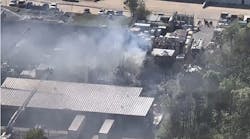Without a doubt, the process of communicating is critical in every phase of emergency services work. Interestingly enough, how effective we are at communicating on the emergency scene will likely determine the outcome of the success or failure of our events. In fact, next to operational tactics, strategy, and execution, proper and effective communications are likely the next most important process that we engage in performing. When communications are effective all seems to go well and when they don't, disaster occurs just about every time.
There are brilliant case studies that identify examples of great communications and studies that describe very, very poor ones. Both will be explored in this column, along with ways to ensure that your critical communications processes are effective. Non-emergency situations require effective communications as well, but the focus of this article will be that of what happens while we are working on the streets.
The $64,000 question to be considered is whether two people can have perfect communications under ideal conditions. As you have likely guessed, this is a trick question. A hint: Are you married or do you have any teenagers at home? Usually, these notions elicit a chuckle or two from most folks, understanding that the process of perfect communications is difficult at best even under ideal conditions. Starting with the basic concept of communicating an idea or thought is developed by a person sending (sender) a message to another person (receiver). This message must travel through some sort of medium, perhaps a portable radio, to the receiving person. Generally, there is some sort of interference (background noise, accents, volume to mention just a few) that degrades the quality of the message. Then the receiving person has to decode the message to provide feedback or take action.
Here's a personal example. In 1990, my son was in the final approach to graduate from high school. He was a good student (Bs and Cs), a quality athlete and in general a very well-behaved young man during his attendance. Well, at about T-minus six weeks, my son asked me to buy him a car to reward him for his efforts. Needless to say, I agreed with very little thought, knowing that he had performed so well.
In the flash of the instant of me saying yes to his request, he was visioning sporting around in a Corvette or perhaps it was a Porsche or same equally exotic and expensive automobile. I had clearly thought that the family VW Bug would be the ticket. Perhaps with new paint, tires, brakes and a little body work, I would be able to provide him with great transportation for an investment of about $1,000. Needless to say, we were both taken aback (a lot for me) in trying to understand each other's concept of a graduation gift. Had our communications failed? The compromise was a pickup truck that was a few years old and bought from a local car dealer.
Now, I must ask, do you think that my namesake was wearing a facepiece and talking to me through an 800-MHz portable radio? Dennis was not crawling through smoke or under great stress in an IDLH atmosphere while he was communicating with his dad. Think back to the situation of the discussion; it was under ideal and relaxed conditions. Neither the sender nor the receiver had to compete with screaming sirens or roaring diesel engines. I assure you that there was no breaking glass, smoke detectors or fire alarm systems squealing providing interference noises.
Tricks of the Trade
When we communicate at most alarms, all of the above factors must be considered and overcome for us to be effective at the mission-critical function of communications. Transmit your message in a concise, clear, calm and commanding (projected, but not screaming) voice. When the transmit key is activated, pause for just a fraction of a second so that (hopefully) your radio will capture the signal, ensuring that the entire statement is heard by all on the alarm. Next, always use standard messages and directions that are incorporated into your department's policy and training. All operational communications must be based on the National Incident Management System (NIMS) model, following the protocols. The day of the "10 codes" and other coded messages have gone the way of the horse-drawn hose wagons (although those were the good old days)! Plain-text messages are a must for all response agencies; include your police department as well. No worries about a missed interrupted code or a misunderstood one with the plain-talk text.
Perhaps the most important concept is that of using the communications order model all of the time. Always briefly, but accurately, repeat the message to ensure understanding and reception of the message. When command gives the order to a truck company to provide positive-pressure ventilation to the fire floor, the truck company assigned must restate the chief's message to ensure that communications has occurred. "Copy," "Received," "OK" or any other limited acknowledgment is just a communications trap waiting to bite an officer. Take the time to briefly restate the core idea of the message to make sure that the direction was received and understood. "Command to Engine 25." "Engine 25. Go with your message, Command." "Engine 25. Advance a 2½-inch handline to the second-floor bedroom in quadrant C — Charles and attack the fire. You are assigned as Division 2 supervisor." "Engine 25 copies. Advance a 2½-inch handline to second-floor bedroom on quadrant C — Charles and attack the fire and assume Division 2 supervisor." "Affirmative Engine 25." The complete idea has been communicated from one person to another with a high degree of understanding.
A running complaint that I hear about using the communications order model is that there is not enough radio time or personnel to use such an elaborate process to get a simple task communicated. The reality is that you can't afford not to use this system, which is intended to prevent mistakes, omissions or duplications of tasks. The last thought for this column is to remember to use the phonic alphabet when communicating, such as C as in Charlie, as in the above example. By using the phonic pronunciation, understanding will be greatly increased and confusion and misunderstanding limited.
Summary
There is an art to learning how to communicate at an emergency incident. There is a great deal of stress and other negative impacting factors that must be resolved to be an effective communicator. There are a lot of items that can be used to help make the process flow smoother, from understanding the process to the difficulty to understanding and applying the tricks of the trade.
Please take the time to learn more about effective communications and training on all of your department's policies and procedures as though your life depends on it, because it does! Until next time, be safe out there!
DENNIS L. RUBIN, a Firehouse® contributing editor, is chief of the District of Columbia Fire and Emergency Medical Services Department. Previously, Rubin was chief of the Atlanta, GA, Fire and Rescue Department. He holds a bachelor of science degree in fire administration from the University of Maryland and an associate in applied science degree in fire science management from Northern Virginia Community College, and is enrolled in the Fire and Emergency Management Administration program at the graduate school of Oklahoma State University. Rubin is a graduate of the National Fire Academy's Executive Fire Officers Program, is a Certified Emergency Manager (CEM) and has obtained the Chief Fire Officer (CFO) designation from the International Association of Fire Chiefs (IAFC). He is an adjunct faculty member of the National Fire Academy author of the book Rube's Rules for Survival.





